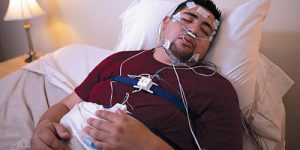 After someone endures a stroke, sleep difficulties often ensue; this is a troubling aftermath of injury that can impact memory, learning, and outcome potential. According to a study conducted by two Centre for Neuro Skills (CNS) neuroscientists, postacute stroke patients show significant disruptions in sleep architecture, which may diminish a person’s ability to fully recover.
After someone endures a stroke, sleep difficulties often ensue; this is a troubling aftermath of injury that can impact memory, learning, and outcome potential. According to a study conducted by two Centre for Neuro Skills (CNS) neuroscientists, postacute stroke patients show significant disruptions in sleep architecture, which may diminish a person’s ability to fully recover.
CNS neuroscientists Dr. Stefanie N. Howell and Dr. Grace S. Griesbach are authors of the paper, “Sleep-wake disturbances in supra-and infratentorial stroke: an analysis of post-acute sleep architecture and apnea,” which appears in the December 2021 issue of Sleep Medicine (see Abstract: https://pubmed.ncbi.nlm.nih.gov/34740169/).
“Sleep-wake disturbances (SWD) are common following stroke, and often extend into the post-acute to chronic periods of recovery,” the paper states. Of particular interest to recovery is reduction in rapid eye movement (REM) sleep.
While there is a breadth of evidence linking SWD and stroke, less work has been done to determine if differences in sleep architecture and apnea severity are dependent on stroke infarct (obstruction in one of the blood vessels) locations. This was a core focus of the sleep study, as CNS is renowned for stroke treatment and treating post stroke issues.
“While there is a strong correlation between stroke and apnea, we, as clinicians, can’t ignore other aspects of sleep,” Dr. Howell said. “By evaluating sleep with full polysomnography (PSG), rather than home sleep tests, we can identify other issues and treat them early in the continuum, with the goal of maximizing the patient’s responsiveness to therapy.”
Methods: A retrospective chart review was conducted of 48 ischemic stroke patients having underwent a full, overnight sleep evaluations (PSG). All patients were over 30 days post-injury at the time of the PSG. Patients were divided into supra- and infratentorial infarct topography groups. Cognitive and outcome measures were also examined.
Results: Patients with infratentorial stroke had poorer sleep efficiency, decreased REM sleep, and higher apnea hypopnea index than those with supratentorial injuries. Longer continuous REM periods were correlated with higher verbal learning/memory scores, higher levels of positive affect, and lower levels of emotional/behavioral dyscontrol.
Conclusions: Infratentorial ischemic stroke patients display significant disruptions in sleep architecture and may require close monitoring for SWDs in the post-acute period to maximize outcome potential. REM sleep is particularly affected when compared to supratentorial ischemic stroke.
“These results indicate a need for thorough sleep evaluations post-stroke,” Dr. Howell said, ”especially considering the significance of injury-induced changes in sleep patterns. Sleep apnea may not be the only culprit. Ultimately, injury location may have an impact on the nature of sleep-wake disturbances in the post-acute to chronic recovery period.”
CNS Monthly Newsletter
The latest CNS updates, including events, company information, and patient care developments
The Inside View
Quarterly magazine focused on brain injury research, rehabilitation, and advancements shaping the field
Sign-up for one or both to stay connected with brain injury news and recover